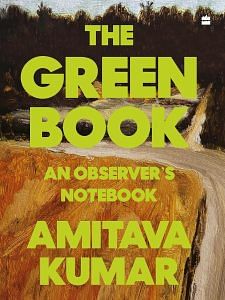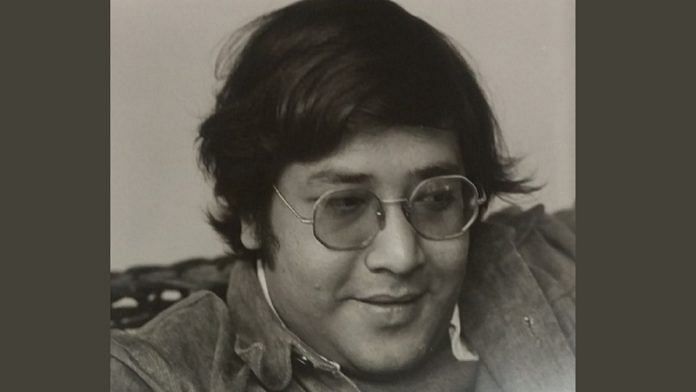In the archives and manuscripts section of the British Library in London, there is a small notebook. It is 4×6 inches in size, with a black-and-white print on the cover that says ‘The Iveagh Bequest, Kenwood’.
The first entry in the notebook begins: ‘Nov. 1st. And so, suddenly, I’m off to India. The last time I had gone it was because of another death—that of Sanjay.’
This notebook belonged to the writer Shiva Naipaul. It has only twenty-eight pages filled with minute, cramped handwriting, while the rest of the pages remain blank. In those few pages, Naipaul made his notes when he flew to India to report on the days that followed Prime Minister Indira Gandhi’s assassination on 31 October 1984.
I am interested in writers’ notebooks. They provide a record of thinking.
If the writer is travelling, you are also able to witness him or her in the act of looking. There is something else that is fascinating about such notebooks. You want to see what made it into the printed copy.
First you have the changes or even corrections made in the hastily-written-down account, and then, perhaps more significantly, it is possible to see the further transformation when you compare what is recorded in the notebook with what appears in published form. All writing is only rewriting. The traveller’s notebook provides evidence of quick, fertile observations and, at the same time, an insight into the process of revision.
It is clear from the first page of Shiva Naipaul’s 1984 notebook that he wrote the first words while he was en route to India. During a stop-over, in ‘the cream-coloured halls of Kuwait airport’, he asks an Australian journalist how long he planned to stay in India. The Australian responds, ‘How long will it take for them to stop killing each other?’ From other conversations on the plane, Naipaul reports: ‘All the way, rumours of riot, of civil disobedience.’ To me, these notes reveal the early eagerness at the start of the journey. The writer wants to absorb everything being discussed around him. He is preparing himself for the real task that lies ahead.
I also detect a certain nervousness.
Like an actor who might look at the mirror in the green room and practice his expressions before stepping on stage, Naipaul is trying to slip into the character of the writer he must become in order to get the job done. While still on the plane, he writes in the notebook that ‘Mrs. G. was the victim of communalism—the curse of India…’ And then goes on: ‘India divides, breaks up each and every way. So, what is the “India” we talk about? Does it exist? Should it exist? Has it earned the right to exist?’ Those two words, underlined by Naipaul for added emphasis, strike me as presumptuous and certainly naïve. These are the thoughts of a man 12,000 metres in the air with no real feel for the power of the nation-state or the undeniable fact of a large, if unwieldy, polity.
I was more drawn to Naipaul’s concrete observations. Here is the next entry, which he has made upon arrival: ‘Delhi in the dawn, smelling of smoke, hazy on the road in from the airport… On a roundabout a burnt-out bus, the smoking remains of a lorry.’
When I read those lines, I stopped. I asked the librarian at the British Library to find for me the newspaper-piece which Naipaul had published under the title ‘The Death of Indira Gandhi’. This is the final form that these notes had taken: ‘The still smouldering wreck of an overturned lorry was abandoned on a grassy roundabout. A calm of sorts had descended after a night of riot and pillage and murder. But it was an eerie dawn. Delhi had become a city of rumor and dread.’
In the above lines, the initial observations have been given a better syntactic structure and rhythm. The simple use of the word ‘rioting’ in the notes has been replaced by the more informed and emphatic phrase: ‘a night of riot and pillage and murder’. (In the printed text there is the beauty of repetition: ‘burnt-out buses, burnt-out taxis’.) The mention of the ‘roundabout’ has been moved to the end of the sentence and the adjective ‘grassy’ added for effect. These are instructive improvements.
In Naipaul’s notes I had liked the sentence ‘A sad, stunned city.’ But I didn’t find it in the final version. I had been attracted by the alliteration, which in that short sentence sounded to my ear like a bell tolling. Why did Naipaul or his editor choose to cut it out? I speculated that Naipaul had seen the deserted streets on his drive from the airport and noted down that phrase but upon learning more about the massacre of the Sikhs he had rightly chosen to highlight the murder and mayhem instead of the grief.
I was sitting in a library in London reading descriptions of a city where I had been living as a student when the events described had taken place. The words I was reading excited a great curiosity in me because there was this writer, older than I was at that time, who was writing about what he saw in Delhi and its streets even as Mrs Gandhi was lying in state in Teen Murti.
I had also liked this observation in the notebook: ‘Mainly men, a sense, I feel of suppressed violence rather than of suppressed grief.’ What had made him write this? I cannot know but they intrigue me. These words didn’t make it to the finished piece—perhaps the editor decided that there wasn’t anything concretely verifiable.
Also read: A 9th-century critic freed Ramayana of religious meanings. It was just literature for him
Another observation I found remarkable, this one from the cremation. Was Naipaul sitting in his hotel room watching television, sipping on a drink, writing down quickly what he so quickly judged?
It wasn’t in the published piece either, perhaps because Naipaul had not been present on the scene—but I liked reading it, not least because it had the familiar irascibility displayed by the writer’s elder brother: ‘The familiar confusion of the Indian ceremonial—the gestures, the undisciplined movements, the lack of perceived pattern, the gracelessness, in a way—casual stepping over the sandalwood, the unorchestrated moments… The tins of ghee—no vessels of beauty. Strange in a ritual of death so ancient.’ The writing here was so bitter, and so deeply felt, that my memory suddenly conjured, with no fealty to reality, the tins of Dalda sitting awkwardly on the ground near where Rajiv Gandhi was circling the pyre.
At the very end, on the last two pages of the notebook, Naipaul had neatly written down in brisk, skeletal phrases the order in which he was going to broach the topics. He followed this structural arrangement to a great extent, especially the repeated switch from descriptions of what he saw in Delhi to a recounting of political history. I liked the rigour or the discipline of this practice. It helps to diagram a piece before you write. But why place it at the very end? I was puzzled by all the sixty blank pages in between. What had he wanted to write there? The notebook takes you closer to the writer but then—no further.
 This excerpt has been picked from Amitava Kumar’s new book ‘The Green Book’, published by Harper Collins India.
This excerpt has been picked from Amitava Kumar’s new book ‘The Green Book’, published by Harper Collins India.






